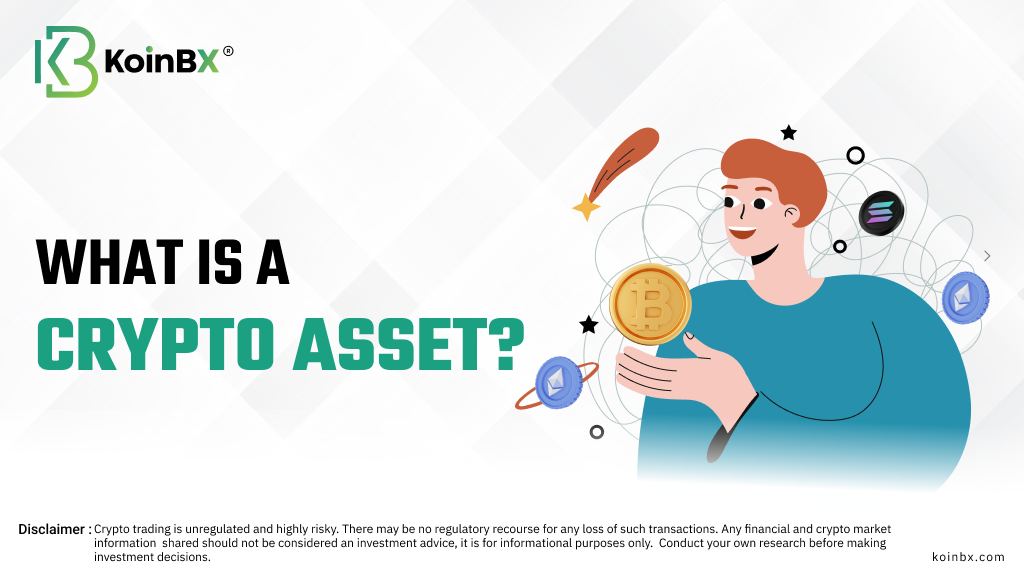Introduction
The landscape of digital finance is in a state of continuous evolution. The emergence of crypto assets represents a significant development within digital finance, transforming our perceptions of money and worth. Crypto assets represent a broad category of digital financial instruments that live on the internet and rely on cryptography and blockchain technology. If you are curious about Bitcoin, NFTs, or utility tokens, understanding crypto assets is your gateway to the exciting digital economy. Let's dive into what crypto assets are and why they're becoming such a vital part of modern finance.
What Is A Crypto Asset?
A crypto asset is a decentralized digital form of asset that relies on cryptography for protection. It operates without the need for intermediaries like banks and other payment systems. The decentralized structure enables direct peer-to-peer (P2P) transactions among individuals. Instead of using physical wallets and bank accounts, individuals can manage their crypto assets through special crypto wallets or crypto exchanges.
You might have heard that crypto asset is stored in these wallets. But in reality, crypto assets are not stored in wallets or exchanges, they are always present on the blockchain. A crypto exchange, for example, keeps the private keys necessary for users to access their funds.
The first and most famous crypto asset is Bitcoin, which came into existence in 2009. Since then, numerous crypto assets have appeared, each with its own unique features and uses. Similar to traditional fiat currencies, crypto assets can be used for buying and selling. Yet, the applications for crypto assets have grown greatly over time to include smart contracts, decentralized finance (DeFi), a store of value, governance, and non-fungible tokens (NFTs).
How Does A Crypto Asset Work?
1. Crypto asset utilizes cryptography for security purposes, employing complex mathematical algorithms to safeguard transactions and shield data from unauthorized access or tampering. These algorithms play a crucial role in upholding user identity privacy and validating transaction authenticity.
2. Transactions on the blockchain are public, with addresses (public keys) being pseudonymous rather than completely anonymous. This means that while transactions are visible on the blockchain, the individuals involved are not easily identifiable. Crypto assets achieve this through cryptographic methods like hash functions and digital signatures.
3. The autonomy of crypto is maintained through a distributed network of computers forming a blockchain, which acts as a decentralized digital ledger storing transaction data across numerous specialized computers on the network. Each of these computers, known as nodes, retains a copy of the ledger, and a consensus algorithm safeguards the integrity of the blockchain by rejecting fake or inconsistent copies. This distributed structure enhances network security by eliminating a single point of failure that malicious actors could exploit, such as a bank vault.
4. Crypto assets enable direct fund transfers between individuals. In a standard crypto asset transaction, the sender begins by generating a digital signature using their private key. The transaction is then transmitted to the network, where nodes validate it by verifying the digital signature and confirming the sender's sufficient funds. Upon validation, the transaction is added to a new block, which is subsequently added to the existing blockchain. Miners handle these processes, relieving users of the need to manage them.
Types of Crypto Assets
Crypto assets come in various forms, each with its own unique characteristics and use cases. Here’s a look at the major categories:
1. Bitcoin: Bitcoin is the most well-known type of crypto asset. It is a decentralized crypto asset that allows peer-to-peer transactions without the need for a central authority. Investors can trade BTC on any trusted crypto exchange.
2. Altcoins: Altcoins refer to any crypto assets other than Bitcoin. This includes popular crypto assets like Ethereum (ETH), Litecoin (LTC), and Polkadot (DOT), each offering unique features and benefits.
3. Utility Tokens: Utility tokens provide access to a product or service within a particular platform. Utility tokens often represent access rights or discounts on a specific service and can be used within their native ecosystems.
4. Security Tokens: Security tokens are digital representations of traditional financial securities, like stocks or bonds, but in a tokenized form. They are subject to regulatory oversight and can represent ownership in a company, voting rights, or other forms of equity. These tokens often aim to merge the benefits of blockchain technology with traditional finance.
5. Stablecoins: Stablecoins are a type of crypto asset designed to maintain a stable value by pegging themselves to traditional assets like the U.S. dollar or gold. Tether (USDT) and USD Coin (USDC) are popular examples of stablecoins.
6. NFTs (Non-Fungible Tokens): NFTs are unique digital assets that represent ownership of a specific item or piece of content, often in the form of art, music, or collectibles. Unlike crypto assets, which are fungible (one Bitcoin is identical to another), NFTs are one-of-a-kind, making them valuable in fields like digital art and gaming.
Also Read: A Beginner’s Guide To Crypto Trading Strategies
How to Buy and Store Crypto Assets?
Getting started with crypto assets is easier than you might think. Here’s a step-by-step guide to buying and storing your first crypto.
Step 1. Choose a Crypto Exchange
To buy a crypto asset, you will need to use a trusted crypto exchange, like KoinBX. Exchanges are online platforms where you can buy, sell, and trade crypto assets.
Step 2. Create an Account
Once you have chosen an exchange, you will need to create an account. This typically involves providing some personal information and verifying your identity. Be sure to use a strong, unique password and enable two-factor authentication (2FA) for added security.
Step 3. Deposit Funds
After setting up your account, you will need to deposit funds to buy crypto assets. Most exchanges accept bank transfers, credit cards, and even PayPal for deposits. Some may also allow you to deposit crypto from another wallet.
Step 4. Buy Crypto Asset
With funds in your account, you can now buy any crypto asset. Simply choose the crypto you want to buy, enter the amount, and confirm the transaction. The crypto will be added to your exchange wallet.
Step 5. Transfer to a Secure Wallet:
For added security, it’s recommended to transfer your crypto from the exchange to a personal wallet. There are different types of wallets to choose from:
Hot Wallets: These are online wallets that are accessible via the internet. They’re convenient but less secure because they’re connected to the internet.
Cold Wallets: These are offline wallets, like hardware wallets, that store your crypto without an internet connection. They’re more secure but less convenient for frequent transactions.
Step 6. Secure Your Wallet
Regardless of the type of wallet you choose, securing it is crucial. Use a strong password, back up your wallet, and consider using a hardware wallet for long-term storage.
Also Read: Safest ways to store your cryptos
Final Thoughts
Crypto assets represent a significant shift in the way we think about money, ownership, and value in the digital age. From crypto assets like Bitcoin and Ethereum to NFTs and stablecoins, these digital assets are reshaping industries and empowering individuals globally. Understanding the basics of crypto assets is crucial in navigating this exciting and ever-changing landscape.
As always, do your research, stay informed, and take security seriously when dealing with crypto assets. The future is bright, and crypto assets are undoubtedly a key part of it.
Download KoinBX Android App | Download KoinBX iOS App
Disclaimer: Any financial and crypto market information shared should not be considered investment advice. It is for informational purposes only. Conduct your own research before making investment decisions. Crypto trading is unregulated and highly risky. There may be no regulatory recourse for any loss of such transactions.






Comments